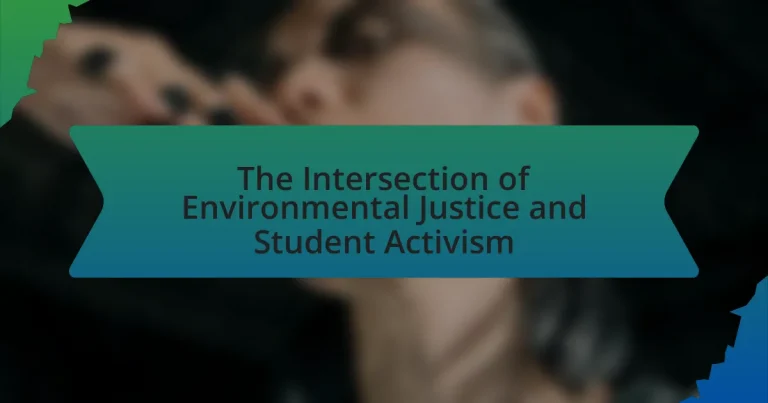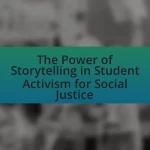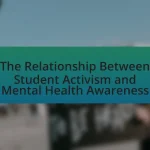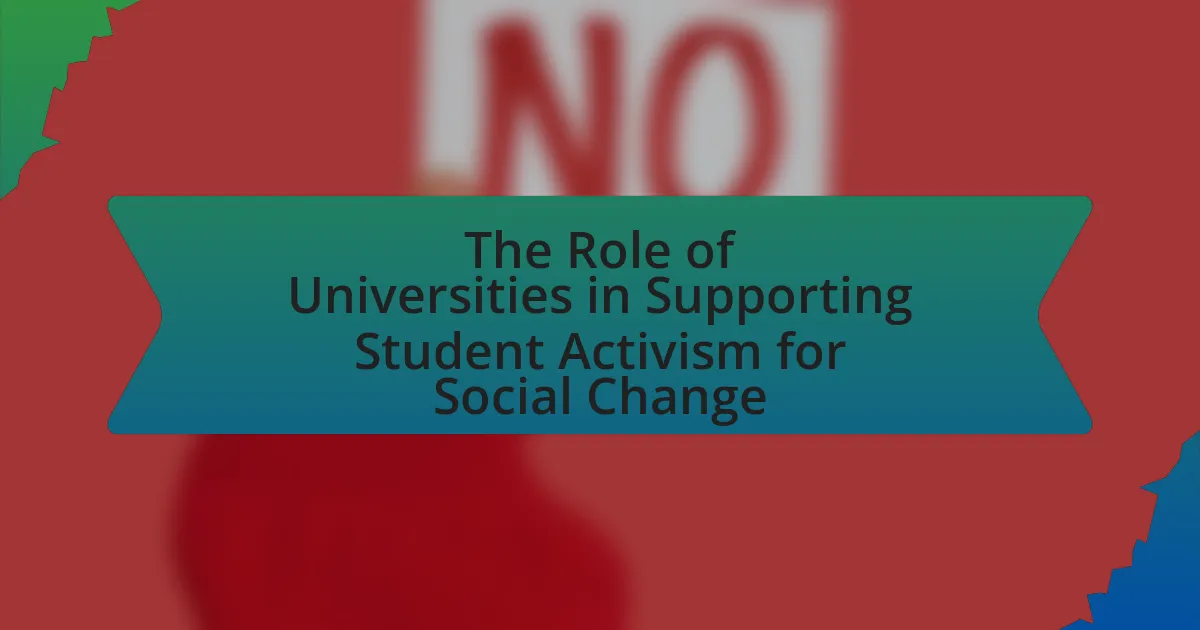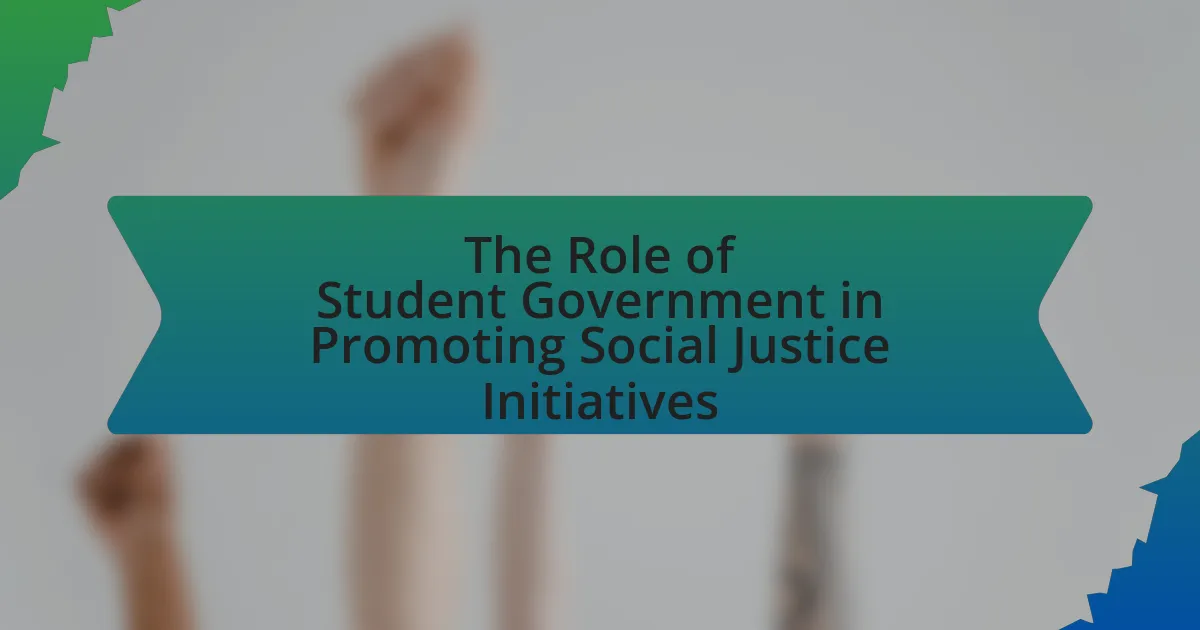The article explores the intersection of environmental justice and student activism, highlighting how students advocate for equitable environmental policies that address the disproportionate impacts of environmental issues on marginalized communities. It discusses the historical roots of this activism, tracing back to the civil rights movements, and examines contemporary movements like the Sunrise Movement and Fridays for Future, which mobilize youth to demand climate action and social equity. Key principles of environmental justice, such as fair treatment and meaningful involvement, are outlined, along with the challenges students face in their activism and the strategies they employ to overcome these barriers. The article emphasizes the significant role of student-led initiatives in shaping environmental policies and promoting systemic change.
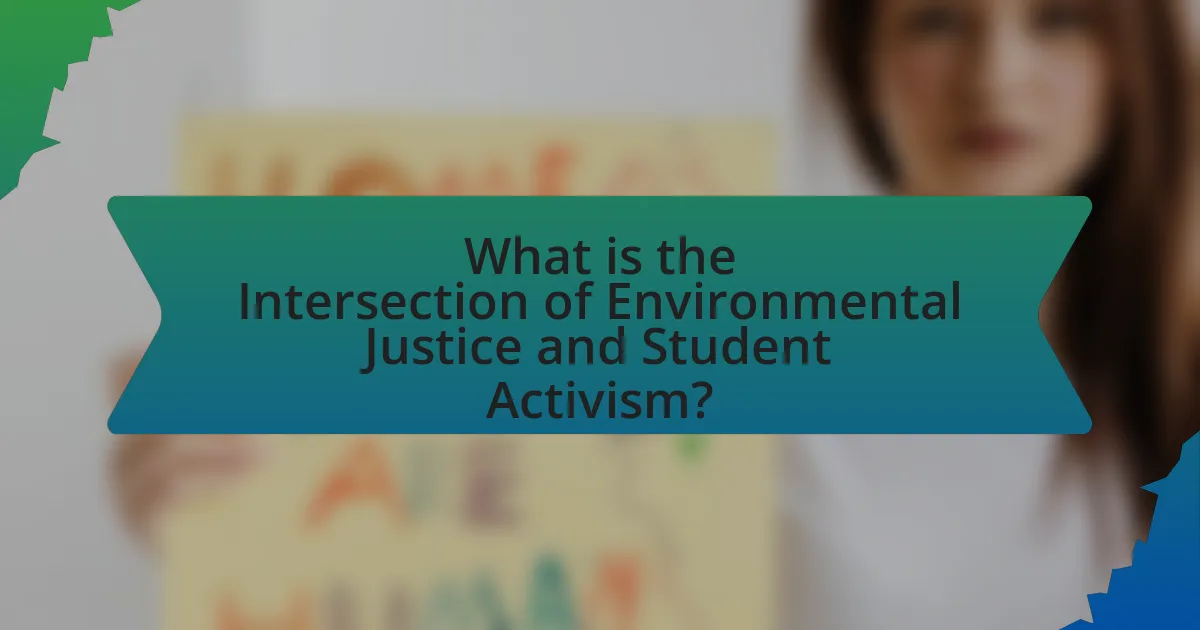
What is the Intersection of Environmental Justice and Student Activism?
The intersection of environmental justice and student activism is characterized by students advocating for equitable environmental policies that address the disproportionate impact of environmental issues on marginalized communities. This activism often manifests through organized movements, campaigns, and educational initiatives aimed at raising awareness about climate change, pollution, and resource access disparities. For instance, the Sunrise Movement, a youth-led organization, emphasizes the need for a Green New Deal that prioritizes both environmental sustainability and social equity, highlighting how low-income and minority communities are often the most affected by environmental degradation. This connection between student activism and environmental justice underscores the role of young people in shaping policies that promote fairness and sustainability in environmental practices.
How do environmental justice and student activism relate to each other?
Environmental justice and student activism are interconnected as students often lead movements advocating for equitable environmental policies that address the disproportionate impact of environmental issues on marginalized communities. This relationship is evident in various student-led initiatives, such as the Sunrise Movement, which mobilizes young people to demand action on climate change and promote social equity. Research shows that youth activism has significantly influenced public discourse and policy changes, highlighting the role of students in pushing for environmental justice. For instance, the 2019 Global Climate Strike, organized by students worldwide, demonstrated their collective power in advocating for sustainable practices and policies that prioritize vulnerable populations.
What are the historical roots of environmental justice in student movements?
The historical roots of environmental justice in student movements can be traced back to the civil rights and anti-war movements of the 1960s and 1970s. During this period, students began to recognize the disproportionate impact of environmental degradation on marginalized communities, leading to activism that linked social justice with environmental issues. For instance, the 1969 Santa Barbara oil spill galvanized student protests, highlighting the need for environmental protection alongside social equity. Additionally, the establishment of Earth Day in 1970 and the formation of organizations like the Student Environmental Action Coalition further solidified the connection between student activism and environmental justice, advocating for policies that address both ecological sustainability and social inequalities.
How has student activism shaped the discourse on environmental justice?
Student activism has significantly shaped the discourse on environmental justice by mobilizing youth to advocate for systemic change and raise awareness about environmental inequalities. For instance, movements like the Sunrise Movement and the global School Strike for Climate, initiated by Greta Thunberg, have highlighted the disproportionate impact of climate change on marginalized communities, thereby influencing public policy and corporate practices. These student-led initiatives have resulted in increased media coverage and public engagement, leading to a broader recognition of environmental justice issues, as evidenced by the incorporation of environmental justice principles in legislative discussions, such as the Green New Deal in the United States.
Why is the intersection of these two areas important today?
The intersection of environmental justice and student activism is important today because it empowers young people to address systemic inequalities related to environmental issues. This intersection fosters a collective movement where students advocate for equitable policies that combat climate change and environmental degradation, particularly in marginalized communities. For instance, the Sunrise Movement, a youth-led organization, has mobilized thousands of students to demand action on climate change, highlighting the disproportionate impact on low-income and minority populations. This activism not only raises awareness but also influences policy decisions, as seen in the increasing incorporation of environmental justice principles in legislative frameworks like the Green New Deal.
What current environmental issues are students advocating for?
Students are currently advocating for climate change action, plastic pollution reduction, and environmental justice. These issues reflect a growing concern among young people regarding the impacts of climate change, with students demanding policies that aim to reduce greenhouse gas emissions and transition to renewable energy sources. Additionally, students are pushing for measures to combat plastic pollution, emphasizing the need for sustainable practices and waste management. Environmental justice is also a key focus, as students highlight the disproportionate effects of environmental degradation on marginalized communities, advocating for equitable access to clean air, water, and green spaces.
How do social movements influence environmental policies through student activism?
Social movements influence environmental policies through student activism by mobilizing young people to advocate for sustainable practices and policy changes. Student-led initiatives, such as the Sunrise Movement and the global School Strike for Climate, have effectively raised awareness about climate change and pressured policymakers to adopt more stringent environmental regulations. For instance, the 2019 climate strikes, which saw millions of students participating worldwide, demonstrated significant public support for climate action, leading to increased political discourse and commitments from various governments to address environmental issues. This activism not only amplifies the voices of youth but also creates a sense of urgency that compels decision-makers to prioritize environmental policies.
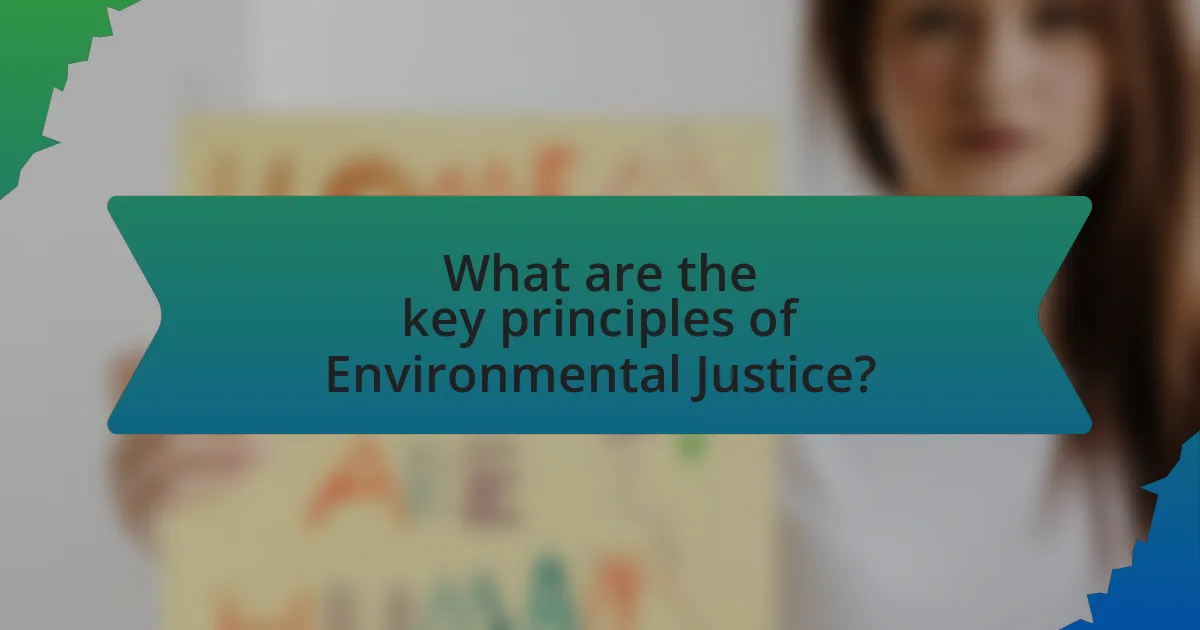
What are the key principles of Environmental Justice?
The key principles of Environmental Justice include the fair treatment and meaningful involvement of all people, regardless of race, color, national origin, or income, in environmental decision-making processes. This principle emphasizes that no group should bear a disproportionate share of negative environmental consequences resulting from industrial, governmental, and commercial operations. Additionally, Environmental Justice advocates for the right to a healthy environment, equitable access to resources, and the protection of vulnerable communities from environmental hazards. These principles are supported by the 1991 Principles of Environmental Justice, which were established during the First National People of Color Environmental Leadership Summit, highlighting the need for systemic change to address environmental inequalities.
How do these principles apply to student activism?
The principles of environmental justice apply to student activism by guiding students to advocate for equitable treatment of all communities affected by environmental issues. These principles emphasize the need for inclusivity, ensuring that marginalized voices are heard in discussions about environmental policies and practices. For instance, student-led movements like the Sunrise Movement focus on climate justice, highlighting how low-income and minority communities disproportionately suffer from environmental degradation. This activism is supported by research indicating that environmental hazards often correlate with socioeconomic status, reinforcing the necessity for students to address these disparities in their advocacy efforts.
What role do equity and inclusion play in student-led environmental initiatives?
Equity and inclusion are fundamental to the success of student-led environmental initiatives as they ensure diverse perspectives and experiences are represented in decision-making processes. When students prioritize equity, they address the disproportionate impacts of environmental issues on marginalized communities, fostering a more just approach to environmental activism. Research indicates that inclusive initiatives lead to more effective solutions, as they incorporate the needs and voices of those most affected by environmental degradation. For instance, a study by the University of California found that diverse teams are more innovative and produce better outcomes in sustainability projects, highlighting the importance of equity and inclusion in driving impactful environmental change.
How can students address systemic inequalities through activism?
Students can address systemic inequalities through activism by organizing campaigns that raise awareness and advocate for policy changes. For instance, students can form coalitions to highlight issues such as environmental racism, which disproportionately affects marginalized communities. Research indicates that youth-led movements, like the Sunrise Movement, have successfully influenced climate policy discussions by emphasizing the need for equitable solutions. By leveraging social media platforms, students can amplify their messages, mobilize support, and engage in direct actions, such as protests or community service initiatives, to challenge systemic barriers. These efforts not only educate peers but also pressure decision-makers to implement fair policies that address the root causes of inequality.
What challenges do students face in advocating for environmental justice?
Students face significant challenges in advocating for environmental justice, primarily due to limited resources and institutional barriers. Many students lack access to funding, mentorship, and platforms to amplify their voices, which hinders their ability to organize effectively. Additionally, they often encounter resistance from established institutions and policymakers who may prioritize economic interests over environmental concerns. Research indicates that youth activism can be marginalized, as seen in the 2019 Global Climate Strike, where student demands were sometimes overshadowed by political agendas. Furthermore, students may struggle with balancing academic responsibilities and activism, leading to burnout and reduced participation. These factors collectively impede their efforts to drive meaningful change in environmental justice.
What are the barriers to effective student activism in this field?
Barriers to effective student activism in the field of environmental justice include lack of resources, limited institutional support, and insufficient awareness of issues. Students often face financial constraints that hinder their ability to organize events or campaigns, as evidenced by a study from the National Student Campaign Against Hunger and Homelessness, which found that 70% of students reported financial barriers to participation in activism. Additionally, many educational institutions may not prioritize or support environmental justice initiatives, leading to a lack of mentorship and guidance for student activists. Furthermore, a lack of awareness about environmental justice issues among the student body can result in low engagement and participation, as highlighted by research from the Environmental Protection Agency, which indicates that only 30% of students are familiar with the concept of environmental justice.
How can students overcome these challenges to make an impact?
Students can overcome challenges in environmental justice activism by leveraging collaboration, education, and advocacy. By forming alliances with local organizations, students can amplify their voices and resources, leading to more significant community impact. Engaging in educational initiatives allows students to raise awareness about environmental issues, fostering a more informed public. Additionally, participating in advocacy efforts, such as lobbying for policy changes, can directly influence decision-makers. Research indicates that collective action, such as the youth-led climate strikes, has successfully pressured governments to address climate change, demonstrating the effectiveness of organized student activism in creating tangible change.
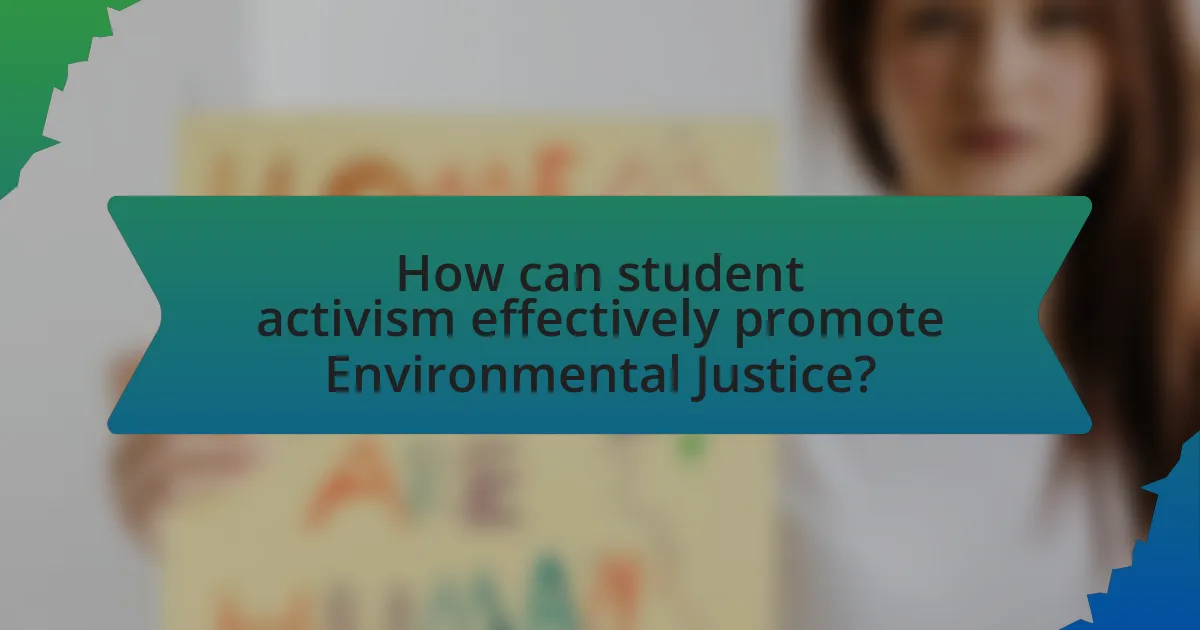
How can student activism effectively promote Environmental Justice?
Student activism can effectively promote Environmental Justice by mobilizing communities, raising awareness, and influencing policy changes. Through organized campaigns, students can highlight environmental issues disproportionately affecting marginalized communities, such as pollution and lack of access to clean resources. For instance, the Sunrise Movement, a youth-led organization, has successfully advocated for the Green New Deal, emphasizing the need for equitable environmental policies. Additionally, student-led initiatives, such as campus sustainability programs, can serve as models for broader community engagement, demonstrating the impact of collective action on local environmental policies. Research indicates that youth activism has historically played a crucial role in environmental movements, with studies showing that engaged students can sway public opinion and legislative agendas, thereby advancing Environmental Justice.
What strategies have proven successful in student-led environmental campaigns?
Successful strategies in student-led environmental campaigns include grassroots organizing, collaboration with local communities, and leveraging social media for awareness and mobilization. Grassroots organizing empowers students to engage their peers and local stakeholders, fostering a sense of ownership and responsibility towards environmental issues. Collaboration with local communities enhances the campaigns’ relevance and impact, as seen in initiatives like the Sunrise Movement, which effectively partnered with marginalized communities to address climate justice. Additionally, social media platforms have proven essential for amplifying messages, mobilizing supporters, and creating viral campaigns, as demonstrated by the global reach of the Fridays for Future movement initiated by Greta Thunberg. These strategies collectively enhance the effectiveness and reach of student-led environmental campaigns.
How can collaboration with local communities enhance student activism?
Collaboration with local communities enhances student activism by providing students with real-world contexts and resources that amplify their voices and initiatives. Engaging with community members allows students to gain insights into local environmental issues, fostering a deeper understanding of the challenges faced by those directly affected. For instance, research conducted by the University of California found that students who partnered with local organizations reported increased motivation and effectiveness in their activism efforts, as they could address specific community needs and leverage local knowledge. This collaboration not only strengthens the impact of student-led initiatives but also builds solidarity between students and community members, creating a unified front for environmental justice.
What role does social media play in mobilizing student activism for environmental justice?
Social media plays a crucial role in mobilizing student activism for environmental justice by providing a platform for awareness, organization, and engagement. It enables students to share information rapidly, connect with like-minded individuals, and coordinate actions such as protests and campaigns. For instance, the #FridaysForFuture movement, initiated by Greta Thunberg, gained global traction through social media, leading to millions of students participating in climate strikes worldwide. This demonstrates how social media can amplify voices, foster community, and drive collective action in the pursuit of environmental justice.
What are some notable examples of successful student activism in environmental justice?
Notable examples of successful student activism in environmental justice include the 2019 Global Climate Strike, where millions of students worldwide, inspired by Greta Thunberg, protested for climate action, leading to increased awareness and policy discussions on climate change. Another example is the University of California’s divestment campaign, which successfully pressured the university system to divest from fossil fuels, demonstrating the power of organized student movements in influencing institutional policies. Additionally, the Sunrise Movement, primarily composed of young activists, has effectively advocated for the Green New Deal, mobilizing support and pushing for legislative changes to address climate justice. These instances illustrate the significant impact of student-led initiatives on environmental justice issues.
Which student-led movements have made significant impacts on environmental policies?
The student-led movements that have made significant impacts on environmental policies include the Sunrise Movement and the Fridays for Future movement. The Sunrise Movement, founded in 2017, advocates for a Green New Deal in the United States, mobilizing young people to demand comprehensive climate action from policymakers. This movement has successfully influenced political discourse and led to the introduction of climate-focused legislation. Similarly, Fridays for Future, initiated by Greta Thunberg in 2018, has galvanized millions of students worldwide to strike for climate action, resulting in increased public awareness and pressure on governments to adopt more stringent environmental policies. Both movements exemplify how student activism can drive substantial changes in environmental policy through grassroots organizing and advocacy.
How have these movements inspired other students globally?
These movements have inspired students globally by fostering a sense of collective responsibility and activism towards environmental issues. For instance, the global climate strikes initiated by students, particularly those inspired by Greta Thunberg, have mobilized millions of young people across various countries, leading to increased awareness and participation in environmental advocacy. According to a report by the United Nations, youth-led movements have significantly influenced policy discussions, with over 1.4 million students participating in climate strikes worldwide in 2019 alone. This demonstrates how grassroots activism can create a ripple effect, encouraging students in different regions to engage in local and global environmental initiatives.
What practical steps can students take to engage in environmental justice activism?
Students can engage in environmental justice activism by participating in local community clean-up events, advocating for policy changes, and raising awareness through educational campaigns. By joining or forming student organizations focused on environmental issues, students can collaborate with like-minded peers to amplify their impact. Additionally, they can attend town hall meetings to voice concerns about environmental policies affecting marginalized communities. Research indicates that grassroots movements, such as those led by students, have historically played a crucial role in advancing environmental justice initiatives, demonstrating the effectiveness of collective action in influencing policy and raising public awareness.
How can students organize effective campaigns on their campuses?
Students can organize effective campaigns on their campuses by clearly defining their goals, building a coalition of supporters, and utilizing various communication channels. Establishing specific objectives helps focus efforts and measure success, while gathering a diverse group of participants enhances credibility and reach. Effective campaigns often leverage social media, campus events, and partnerships with local organizations to amplify their message and engage a broader audience. Research indicates that campaigns with clear messaging and community involvement are more successful; for example, a study by the American College Health Association found that student-led initiatives with strong community ties resulted in higher participation rates and greater impact on campus policies.
What resources are available for students interested in environmental justice activism?
Students interested in environmental justice activism can access various resources, including organizations, educational programs, and online platforms. Notable organizations such as the Sierra Club and Greenpeace provide educational materials, volunteer opportunities, and advocacy training specifically focused on environmental justice issues. Additionally, universities often have environmental studies programs that include courses on social justice and activism, equipping students with the necessary knowledge and skills. Online platforms like the Environmental Justice Atlas offer data and case studies on environmental conflicts, enabling students to engage with real-world issues. These resources collectively support students in their activism efforts by providing knowledge, community, and practical tools for effective engagement.
